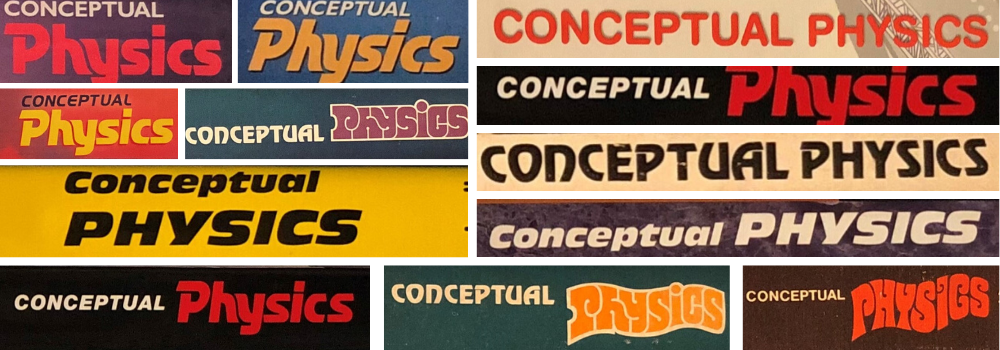
Conceptual Physics
Conceptual Physics

The Niels Bohr Library & Archives, like many institutions, has a backlog of donations. As the library’s metadata specialist, I am regularly processing books that, while new to NBLA, are generally a few decades old. This is not to say that we have a decade-old backlog. Rather, our donations often come from physicists whose collections span the length of their careers. This year, I cataloged a donation that included nine different editions of the same textbook: Conceptual Physics.
In publication for nearly the past 50 years, Paul G. Hewitt’s Conceptual Physics has become a staple for many physics educators. The textbook was first published in 1971 and has since expanded to accommodate a wide range of audiences. Hewitt’s high school level and college level texts (the college level text is currently in its 12th edition) are perhaps his most well known. Yet, Hewitt has not shied away from niche audiences. NBLA's recent donation included an unpublished copy of a Conceptual Physics text prepared for elementary school teachers. This particular manuscript was likely the foundation for Hewitt’s 1998 mouthful, Conceptual Physics for Parents and Teachers: Especially Elementary School Teachers, Who, After Parents, Provide the Learning Foundation for Children—Mechanics.
Conceptual Physics: The High School Physics Program, 2nd ed. ©1992 by Paul G. Hewitt
As evidenced in the publications above, Conceptual Physics aims to make physics approachable to everyone. Hewitt attracts non-scientists by “translating the central concepts of physics from mathematical language to common English”.1 Conceptual Physics’ accessibility is achieved in part through its use of illustrations. Hewitt, in addition to being the author, is also the textbooks’ illustrator. He has a background as a sign painter2, and his drawings greatly aid in the readability of physics concepts.
Take for example Newton's laws of motion. One could brush up on Latin and review our third edition copy of Newton's Principia. Or, one could look at chapters three, four and five of our second edition copy of Conceptual Physics, which are sprinkled with visual aids. Both texts are important in their own rights, but it's fairly safe to say Conceptual Physics is more welcoming to the layperson.
Keeping his teachings contemporary, Hewitt has moved many of his physics lessons online with the creation of Hewitt Drew It, a series of screencasts that have been animated in Hewitt’s signature cartoon style. There are currently over 100 bite-sized (five to ten minute) videos available to watch, for free, on YouTube.
Hewitt’s status as a physics educator has been exemplified in part by his prestigious awards, but also by his works’ endless relevance. Case in point, the March 2020 cover of The Physics Teacher features one of Hewitt’s “Figuring Physics” cartoons on rainbows.
As Ex Libris Universum readers may already know, NBLA collects successive editions of scientific texts and Conceptual Physics is no exception. We currently have two shelves dedicated to the textbooks and their accompanying materials. This count excludes Hewitt’s contributions to the kindred texts: Conceptual Physical Science and Conceptual Integrated Science, of which we also collect successive editions. While a complete collection of Hewitt’s work will test the boundaries of our building’s infrastructure, NBLA remains committed to collecting this expansive popular physics textbook.

Conceptual Physics, Conceptual Integrated Science, and Conceptual Physical Science on NBLA's shelves
References
1. “Paul G. Hewitt.” Conceptual Physics. Accessed March, 1, 2020. http://www.conceptualphysics.com/paul-g-hewitt.html.
2 “Paul Hewitt.” Oral History Interviews. January 20, 2020. https://www.aip.org/history-programs/niels-bohr-library/oral-histories/….




Add new comment